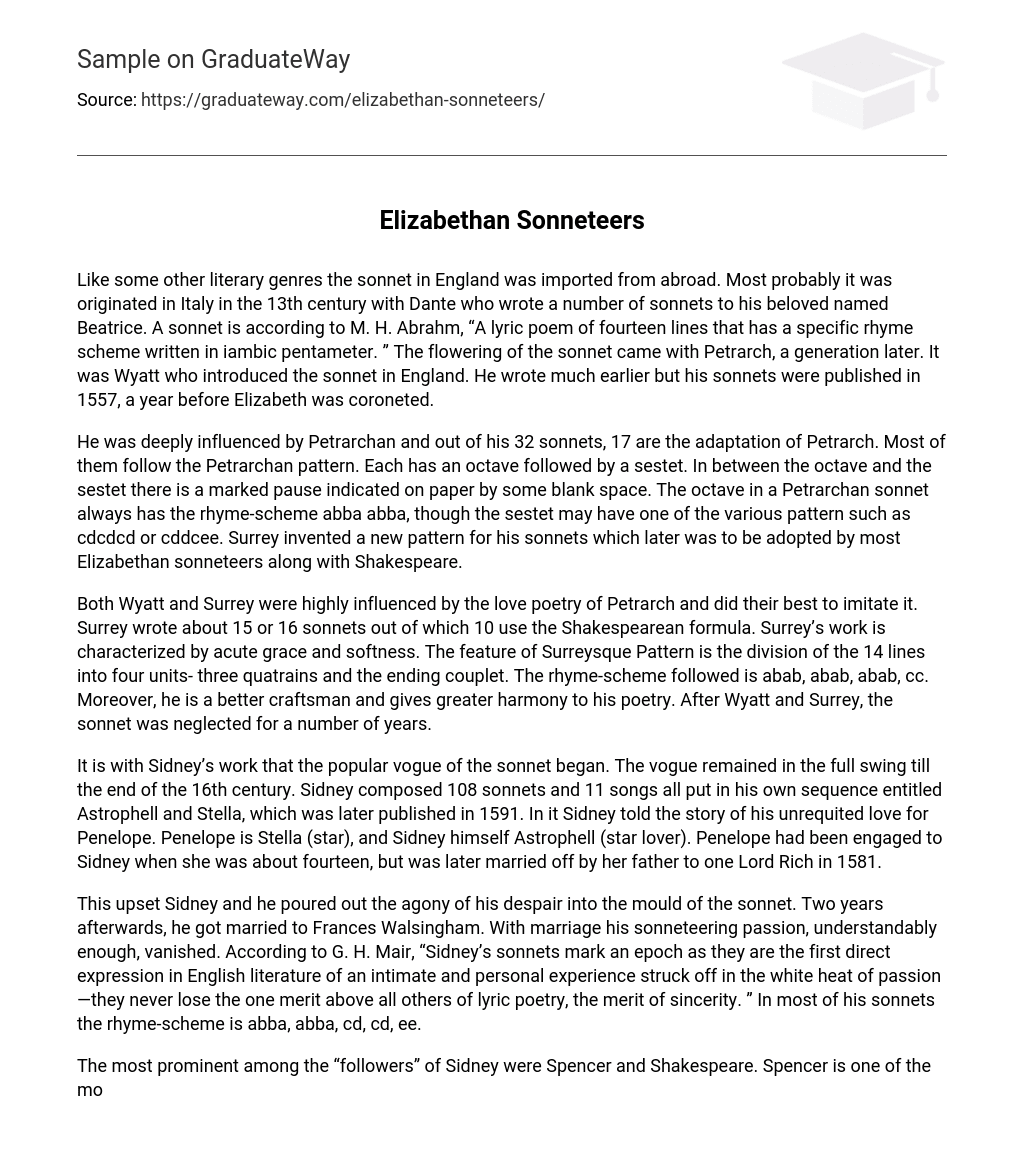Like some other literary genres the sonnet in England was imported from abroad. Most probably it was originated in Italy in the 13th century with Dante who wrote a number of sonnets to his beloved named Beatrice. A sonnet is according to M. H. Abrahm, “A lyric poem of fourteen lines that has a specific rhyme scheme written in iambic pentameter. ” The flowering of the sonnet came with Petrarch, a generation later. It was Wyatt who introduced the sonnet in England. He wrote much earlier but his sonnets were published in 1557, a year before Elizabeth was coroneted.
He was deeply influenced by Petrarchan and out of his 32 sonnets, 17 are the adaptation of Petrarch. Most of them follow the Petrarchan pattern. Each has an octave followed by a sestet. In between the octave and the sestet there is a marked pause indicated on paper by some blank space. The octave in a Petrarchan sonnet always has the rhyme-scheme abba abba, though the sestet may have one of the various pattern such as cdcdcd or cddcee. Surrey invented a new pattern for his sonnets which later was to be adopted by most Elizabethan sonneteers along with Shakespeare.
Both Wyatt and Surrey were highly influenced by the love poetry of Petrarch and did their best to imitate it. Surrey wrote about 15 or 16 sonnets out of which 10 use the Shakespearean formula. Surrey’s work is characterized by acute grace and softness. The feature of Surreysque Pattern is the division of the 14 lines into four units- three quatrains and the ending couplet. The rhyme-scheme followed is abab, abab, abab, cc. Moreover, he is a better craftsman and gives greater harmony to his poetry. After Wyatt and Surrey, the sonnet was neglected for a number of years.
It is with Sidney’s work that the popular vogue of the sonnet began. The vogue remained in the full swing till the end of the 16th century. Sidney composed 108 sonnets and 11 songs all put in his own sequence entitled Astrophell and Stella, which was later published in 1591. In it Sidney told the story of his unrequited love for Penelope. Penelope is Stella (star), and Sidney himself Astrophell (star lover). Penelope had been engaged to Sidney when she was about fourteen, but was later married off by her father to one Lord Rich in 1581.
This upset Sidney and he poured out the agony of his despair into the mould of the sonnet. Two years afterwards, he got married to Frances Walsingham. With marriage his sonneteering passion, understandably enough, vanished. According to G. H. Mair, “Sidney’s sonnets mark an epoch as they are the first direct expression in English literature of an intimate and personal experience struck off in the white heat of passion—they never lose the one merit above all others of lyric poetry, the merit of sincerity. ” In most of his sonnets the rhyme-scheme is abba, abba, cd, cd, ee.
The most prominent among the “followers” of Sidney were Spencer and Shakespeare. Spencer is one of the most important sonneteers of the Elizabethan age. He composed 88 sonnets of love addressed to Elizabeth Boyle. His sonnets are unique for their purity. Spencer’s sonnet sequence ‘Amoretti’ can be divided into two unequal parts. Sonnets one to sixty two deal with the non responded love. Sonnets 63 to 84 deal with the happiness of lover when his beloved surrenders herself happily to him. The usual rhyme-scheme of Spencer’s sonnet is –aabab, bcbc, cdcd, ee, which later came to be known as Spenserian pattern.
It will be seen that the three quatrains are very deftly interlinked through rhyme. The last rhyme of the first quatrain is used in the first line of the second and the last rhyme of second quatrain is likewise used in the first line of the third. The result is a complicated rhyme pattern with a harmonious effect which is so characteristic of Spenser’s poetry. Shakespeare’s sonnets have proved an attractive bone for the generation after generation of critics to grow (to torture) it. These sonnets, some 154 in number, were first published in a body in 1609.





